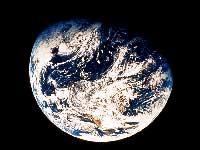The Random Fusion in Earth's History
2001/04/17 Galarraga Aiestaran, Ana - Elhuyar Zientzia
The first one to propose that cyclical changes in geometry between the Sun and Earth could influence climate change on Earth was astrophysicist Milutin Milankovitch. The most important factors are eccentricity, obliquity, and precesion.
Eccentricity is the cyclical variation of the shape of the earth's orbit around the Sun, which, according to this cycle of about 100,000 years, is almost circular to elliptical.

The oblique, on the other hand, is the inclination of the axis of the Earth with respect to the plane of the orbit and varies in a cycle of 41,000 years between 22.1 and 24,5 degrees.
The pressure has a cycle of 21,000 years and is a gradual change in the direction of the earth axis.
These changes are stored in the marine sediment. For example, according to the oxygen isotopes of the shells of the marine animals, variations in the temperature of the water and in the volume of the ice layer of the time can be known. Zachos and their team study the sediment layer of the Upper Oligocene and Lower Miocene and study a period of five million years.
Unexpectedly, they discover that at a given time the orbital forces that caused climate cooling had joined the ice formation. About 23 million years ago, the eccentricity of the Earth was at a low point, that is, the orbit was almost circular, so the distance Earth-Sun hardly varied throughout the year. In addition, the tilt of the Earth's axis hardly varied, and the seasonal changes hardly appreciated. This caused the summer temperatures of the poles to barely increase and a new era of ice began.
The unification of this type by the cycles of the Earth's orbit is very rare and, according to the study carried out, can be an explanation to understand what happened at the limit of those periods.

Gai honi buruzko eduki gehiago
Elhuyarrek garatutako teknologia





